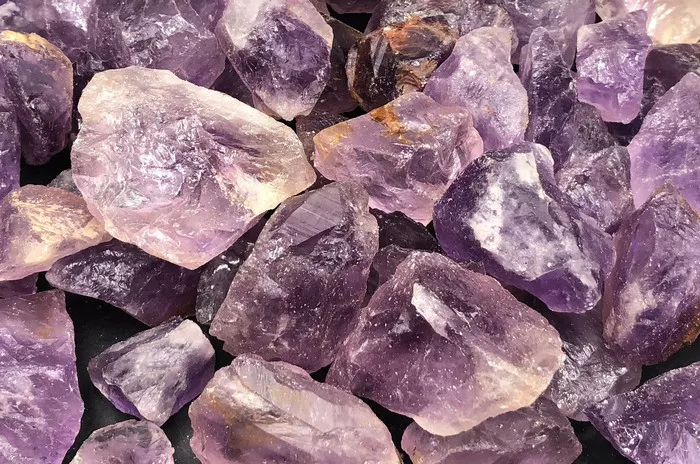Amethyst, with its captivating purple hue, has been a cherished gemstone for centuries. However, in recent times, a unique variation known as Chevron Amethyst has gained popularity in the jewelry market. Chevron Amethyst is characterized by its distinctive V-shaped banding patterns, which add an intriguing element to its allure. As consumers and collectors seek to understand the origins of this captivating gem, questions arise regarding its authenticity and whether it is genuinely a natural occurrence. In this article, we delve into the world of Chevron Amethyst to shed light on its formation, characteristics, and the debate surrounding its natural status.
What is the composition of chevron amethyst?
Amethyst, the purple variety of quartz, is typically formed from silicon dioxide (SiO2) and gains its distinctive color from traces of iron and other elements. Chevron Amethyst, on the other hand, exhibits additional banding patterns of white quartz that create the chevron-like formations, alternating with the characteristic purple layers. This unique appearance has led to speculation about the gemstone’s authenticity.
Is Chevron Amethyst Truly Natural?
Chevron Amethyst’s natural formation occurs under specific geological conditions. As magma cools and crystallizes within the Earth’s crust, cavities or voids may form. Over time, silica-rich solutions infiltrate these voids, and as they cool and solidify, they deposit minerals, including quartz, in successive layers. The combination of purple amethyst and white quartz layers results in the distinctive chevron pattern. These natural processes can take millions of years to create Chevron Amethyst.
Can Chevron Amethyst Be Manufactured?
Chevron Amethyst can be manufactured through synthetic reproduction methods. Using hydrothermal or melt processes, gemologists and scientists can replicate the conditions under which natural Chevron Amethyst forms, resulting in gem-quality crystals that mimic the appearance of genuine Chevron Amethyst.
In the synthetic creation of Chevron Amethyst, the alternating layers of purple amethyst and white quartz are carefully simulated to achieve the characteristic V-shaped banding patterns. These synthetic versions can closely resemble the natural gemstone, making it challenging to distinguish between the two based on visual appearance alone.
While natural Chevron Amethyst is rarer and may hold more value for collectors and investors, synthetic versions offer a more affordable option for those who appreciate the gemstone’s unique beauty without the premium price tag.
How to Distinguish Natural Chevron Amethyst from Synthetic Amethyst?
Distinguishing natural Chevron Amethyst from synthetic amethyst can be challenging, but several methods and observations can help identify their differences. Here are some ways to tell them apart:
1. Gemological Testing:
Seek the expertise of a certified gemologist or a reputable gemological laboratory. They can conduct advanced tests, such as spectroscopy, microscopy, and polarized light analysis, to examine the gemstone’s internal structure, inclusions, and other characteristics that may indicate its origin.
2. Color and Pattern:
Natural Chevron Amethyst often exhibits a more distinct and intricate V-shaped banding pattern than synthetic versions. Look closely at the banding to check for irregularities and variations, which are typical of natural formations.
3. Inclusions:
Natural gemstones are more likely to contain inclusions, tiny imperfections or foreign materials trapped during the crystal’s formation. While inclusions can lower a gemstone’s clarity, they are signs of its natural origin.
4. Growth Lines:
Natural crystals often show growth lines or striations that indicate their slow development over time. These lines may not be as evident in synthetic amethyst, which is produced more rapidly.
5. Transparency:
Natural Chevron Amethyst may have variations in transparency along the banding layers, whereas synthetic amethyst may exhibit more consistent transparency.
Remember that while these methods can be helpful, they may not always provide a definitive answer. If you are uncertain about the authenticity of a Chevron Amethyst, consult a professional gemologist to ensure an accurate assessment. Transparent disclosure and ethical practices are essential in the gemstone trade, so always buy from reputable sources to make an informed and confident purchase.
What is Chevron Amethyst good for?
Chevron Amethyst is a unique variety of amethyst that features bands or chevrons of white quartz running through the purple amethyst crystal. It combines the properties of both amethyst and quartz, providing a range of benefits:
1. Spiritual Growth:
Chevron Amethyst is believed to enhance spiritual awareness and intuition. It can aid in meditation, connecting you to higher realms and expanding consciousness.
2. Protection:
As a combination of amethyst and quartz, it is considered to be a powerful protective stone, shielding the wearer from negative energies and psychic attacks.
3. Balancing and Calming:
The soothing energy of amethyst combined with the balancing nature of quartz can bring a sense of calmness, reducing stress, anxiety, and promoting emotional healing.
4. Creativity and Focus:
This stone is said to promote creativity and aid in decision-making processes by enhancing mental clarity and focus.
The healing properties of gemstones are based on metaphysical beliefs and not scientifically proven. As with any alternative healing methods, using Chevron Amethyst as a tool for wellness should complement, not replace, professional medical advice and treatment.
Conclusion
In the captivating world of gemstones, Chevron Amethyst stands out with its mesmerizing V-shaped banding patterns, evoking wonder and curiosity among enthusiasts. Our exploration of this enigmatic gemstone reveals that distinguishing between natural and synthetic Chevron Amethyst can be a challenging task.
While natural Chevron Amethyst is considered rarer and more valuable, the allure of its synthetic counterpart lies in its affordability without compromising on visual appeal. As the gemstone market continues to evolve, staying vigilant and seeking professional expertise will be essential in navigating the nature vs. synthesis debate.


